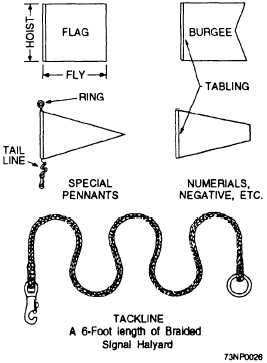you may hear the sound of gas escaping. When safety
vents have operated, batteries must still be handled with
care.
Do not remove any covers during daylight. During
nighttime operation do not leave sights pointed at a
bright light for extended periods of time, because the
image intensifier tube may be permanently damaged.
Before using any NVSs, you must review the
technical manual.
FLAGS AND HALYARDS
LEARNING OBJECTIVE: Identify the
procedures for the proper care and repair of
flags, for going aloft, and for splicing and
reeving halyards.
Working with flags is an integral part of the
Signalman's job. Flags are used to send messages and
tactical signals during daylight, to identify a ship's
nationality, and, on occasion, to indicate the seniority
of an officer or civil official on board. Individual flags
are discussed in other chapters. This section is
confined to describing flags and halyards in general.
Bunting, the cloth of which flags are made, is
available in cotton, wool, and nylon. Because cotton
costs less, it is usually used in simply designed flags
and pennants. Cotton bunting is not as durable as wool
and will not stand as much weathering, but it is often
less expensive to wear out two cotton flags than one
woolen flag. Flags and pennants that are in almost
constant use, however, usually are made of wool or
nylon. Wool is also used in flags of complicated design
when the original cost of material is less important
than the labor involved.
FLAG NOMENCLATURE
The parts of flags and pennants are shown in figure
2-20. The fly is the horizontal length of the flag, the
hoist is the vertical width. Tabling is a reinforced
border of light duck, stitched to the edge of the flag at
the hoist. A length of line leads through the tabling, at
the top of which a ring is spliced. The other end of the
line, extending several inches below the tabling, is the
tail line. A snap hook is attached to it. The tail line
serves as a spacer between flags, and the snap and ring
are used to secure flags to each other in a hoist.
Figure 2-20.—Parts of flags and pennants.
CARE OF FLAGS
Wind and moisture cause flags to deteriorate
rapidly. Unless stowed promptly and handled
carefully, flags quickly become dirty. The flagbag (fig.
2-21) is designed to provide proper stowage for the
Figure 2-21.—Flagbag.
2-20



